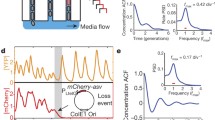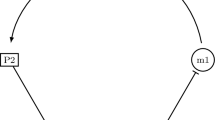Abstract
We model in detail a simple synthetic genetic clock that was engineered in Atkinson et al. (Cell 113(5):597–607, 2003) using Escherichia coli as a host organism. Based on this engineered clock its theoretical description uses the modelling framework presented in Kirkilionis et al. (Theory Biosci. doi:10.1007/s12064-011-0125-0, 2011, this volume). The main goal of this accompanying article was to illustrate that parts of the modelling process can be algorithmically automatised once the model framework we called ‘average dynamics’ is accepted (Sbano and Kirkilionis, WMI Preprint 7/2007, 2008c; Kirkilionis and Sbano, Adv Complex Syst 13(3):293–326, 2010). The advantage of the ‘average dynamics’ framework is that system components (especially in genetics) can be easier represented in the model. In particular, if once discovered and characterised, specific molecular players together with their function can be incorporated. This means that, for example, the ‘gene’ concept becomes more clear, for example, in the way the genetic component would react under different regulatory conditions. Using the framework it has become a realistic aim to link mathematical modelling to novel tools of bioinformatics in the future, at least if the number of regulatory units can be estimated. This should hold in any case in synthetic environments due to the fact that the different synthetic genetic components are simply known (Elowitz and Leibler, Nature 403(6767):335–338, 2000; Gardner et al., Nature 403(6767):339–342, 2000; Hasty et al., Nature 420(6912):224–230, 2002). The paper illustrates therefore as a necessary first step how a detailed modelling of molecular interactions with known molecular components leads to a dynamic mathematical model that can be compared to experimental results on various levels or scales. The different genetic modules or components are represented in different detail by model variants. We explain how the framework can be used for investigating other more complex genetic systems in terms of regulation and feedback.












Similar content being viewed by others
References
Alon U (2006) An introduction to systems biology: design principles of biological circuits. Chapman and Hall/CRC, London
Atkinson MR et al (2002a) Governor of the glnAp2 promoter of Escherichia coli. Mol Microbiol 46(5):1247–1257
Atkinson MR et al (2002b) Context-dependent functions of the PII and GlnK signal transduction proteins in Escherichia coli. J Bacteriol 184(19):5364–5375
Atkinson MR et al (2002c) Activation of the glnA, glnK, and nac promoters as Escherichia coli undergoes the transition from nitrogen excess growth to nitrogen starvation. J Bacteriol 184(19):5358–5363
Atkinson MR, Ninfa AJ (1999) Characterization of the GlnK protein of Escherichia coli. Mol Microbiol 32(2):301–313
Atkinson MR et al (2003) Development of genetic circuitry exhibiting toggle switch or oscillatory behavior in Escherichia coli. Cell 113(5):597–607
Bahl CP et al (1977) Minimal length of the lactose operator sequence for the specific recognition by the lactose repressor. Proc Natl Acad Sci USA 74(3):966–970
Barkley MD et al (1975) Interaction of effecting ligands with lac repressor and repressor-operator complex. Biochemistry 1(8):1700–1712
Bartel D (2004) MicroRNAs: genomics, biogenesis, mechanism, and function. Cell 116:281–297
Battle A et al (2010) Automated identification of pathways from quantitative genetic interaction data. Mol Syst Biol 6:379
Bintu L et al (2005a) Transcriptional regulation by the numbers: models. Curr Opin Genet Dev 15(2):116–124
Bintu L et al (2005b) Transcriptional regulation by the numbers: applications. Curr Opin Genet Dev 15(2):125–135
Blauwkamp T, Ninfa AJ (2002) Physiological role of the GlnK signal transduction protein of Escherichia coli: survival of nitrogen starvation. Mol Microbiol 46(1):203–214
Bockhorst J et al (2003) A Bayesian network approach to operon prediction. Bioinformatics 19(10):1227–1235
Branicky MS (2005) Introduction to hybrid systems. In: Hristu-Varsakelis D, Levine WS (eds) Handbook of networked and embedded control systems. Birkhäuser, Boston, pp 91–116
Broom BM et al (2010) Building networks with microarray data. Methods Mol Biol 620:315–343
Domijan M, Kirkilionis M (2008) Graph theory and qualitative analysis of reaction networks. Netw Heterog Media 3(2):295–322
Dufva M (2009) Introduction to microarray technology. Methods Mol Biol 529:1– 22
Elowitz MB, Leibler S (2000) A synthetic oscillatory network of transcriptional regulators. Nature 403(6767):335–338
Galperin MY, Koonin EV (2010) From complete genome sequence to complete understanding? Trends Biotechnol 28(8):398-406
Gardner TS, Cantor CR, Collins JJ (2000) Construction of a genetic toggle switch in Escherichia coli. Nature 403(6767):339–342
Gilbert W., Maxam A. (1973) The nucleotide sequence of the lac operator. Proc Natl Acad Sci USA 70(12):3581–3584
Gillespie DT (2007) Stochastic simulation of chemical kinetics. Annu Rev Phys Chem 58:35–55
Guantes R, Poyatos JF (2006) Dynamical principles of two-component genetic oscillators. PLoS Comput Biol 2(3):e30
Hasty J, McMillen D, Collins JJ (2002) Engineered gene circuits. Nature 420(6912):224–230
Jacob F., Monod J. (1961) On the regulation of gene activity. Cold Spring Harb Symp Quant Biol 26:193–211
Jaimovich A et al (2010) Modularity and directionality in genetic interaction maps. Bioinformatics 26(12):i228–i236
Janus U (2009) Biochemical systems analysis: a study of function and design in molecular biology. Ph.D thesis, University of Warwick
Julius AA, Sakar MS, Bemporad A, Pappas GJ (2007) Hybrid model predictive control of induction of Escherichia coli. In: Proceedings of the 46th IEEE conference on decision and control, New Orleans, LA, USA, 12–14 Dec
Kirkilionis M (2010) Exploration of cellular reaction systems. Briefings Bioinformatics 11(1):153–178
Kirkilionis M, Sbano L (2010) An averaging principle for combined interaction graphs. Connectivity and applications to genetic switches. Adv Complex Syst 13(3):293–326
Kirkilionis M, Janus U, Sbano L (2011) Multi-scale genetic dynamic modelling I: an algorithmic Markov chain based approach. Theory Biosci. doi:10.1007/s12064-011-0125-0
Lee S-Y et al (2003) Regulation of the transcriptional activator NtrC1: structural studies of the regulatory and AAA+ ATPase domains. Genes Dev 17(20):2552–2563
Lewis M (2005) The lac repressor. Comptes Rendus Biologies 328(6):521–548
Merris R (1997) Multilinear algebra. Gordon and Beach Science Publishers, Amsterdam
Metzker ML (2010) Sequencing technologies—the next generation. Nat Rev Genet 11(1):31-46
Morelli LG, Jülicher F (2007) Precision of genetic oscillators and clocks. Phys Rev Lett 98(22):228101
Müller J, Öhler S, Müller-Hill B (1996) Repression of lac-promoter as a function of distance, phase and quality of an auxiliary lac-operator. J Mol Biol 257(1):21–29
Narang A (2006) Comparative analysis of some models of gene regulation in mixed-substrate microbial growth. J Theor Biol, 242(2):489–501
Ninfa AJ, Atkinson MR (2000) PII signal transduction proteins. Trends Microbiol 8(4):172–179
Ninfa AJ, Magasanik B (1986) Covalent modification of the glnG product, NRI, by the glnL product, NRII, regulates the transcription of the glnALG operon in Escherichia coli. Proc Natl Acad Sci USA 83(16):5909–5913
Ninfa AJ, Reitzer L, Magasanik B (1987) Initiation of transcription at the bacterial glnAp2 promoter by purified E. coli components is facilitated by enhancers. Cell 50(7):1039–1046
Öhler S et al (1990) The three operators of the lac operon cooperate in repression. EMBO J 9(4):973–979
Öhler S et al (1994) Quality and position of the three lac operators of E. coli define efficiency of repression. EMBO J 13(14):3348–3355
Pioszak AA, Ninfa AJ (2004) Mutations altering the N-Terminal receiver domain of NRI (NtrC) that prevent dephosphorylation by the NRII-PII complex in Escherichia coli. J Bacteriol 186(17):5730–5740
Porter SC et al (1993) Oligomerization of NTRC at the glnA enhancer is required for transcriptional activation. Genes Dev 7(11):2258–2273
Posada D (2009) Bioinformatics for DNA sequence analysis. Humana Press, New York
Reitzer L (2003) Nitrogen assimilation and global regulation in Escherichia coli. Annu Rev Microbiol 57(1):155–176
Reitzer L, Magasanik B (1985) Expression of glnA in Escherichia coli is regulated at tandem promoters. Proc Natl Acad Sci USA 82(7):1979–1983
Riggs A, Suzuki H, Bourgeois S (1970) lac repressor-operator interaction: I. Equilibrium studies. J Mol Biol 48(1):67–83
Sadler JR, Sasmor H, Betz JL (1983) A perfectly symmetric lac operator binds the lac repressor very tightly. Proc Natl Acad Sci USA 80(22):6785–6789
Sbano L, Kirkilionis M (2008a) Multiscale analysis of reaction networks. Theory Biosci 127:107–123
Sbano L, Kirkilionis M (2008b) Molecular systems with infinite and finite degrees of freedom. Part I: Multi-scale analysis. WMI Preprint 5/2007. Available at: arXiv:0802.4259v2 [q-bio.BM]
Sbano L, Kirkilionis M (2008c) Molecular systems with infinite and finite degrees of freedom. Part II: Deterministic dynamics and examples. WMI Preprint 7/2007. Available at: arXiv:0802.4279v1 [q-bio.MN]
Schadt EE et al (2010) Computational solutions to large-scale data management and analysis. Nat Rev Genet 11(9):647-657
Sevenich FW et al (1998) DNA binding and oligomerization of NtrC studied by fluorescence anisotropy and fluorescence correlation spectroscopy. Nucleic Acids Res 26(6):1373–1381
Shiau SP et al (1992) Role of nitrogen regulator I (NtrC), the transcriptional activator of glnA in enteric bacteria, in reducing expression of glnA during nitrogen-limited growth. J Bacteriol 174(1):179–185
Su W et al (1990) DNA-looping and enhancer activity: association between DNA-bound NtrC activator and RNA polymerase at the bacterial glnA promoter. Proc Natl Acad Sci USA 87(14):5504–5508
Vilar JMG et al (2002) Mechanisms of noise-resistance in genetic oscillators. Proc Natl Acad Sci USA 9(99): 5988–5992
Vilar JMG, Leibler S (2003) DNA looping and physical constraints on transcription regulation. J Mol Biol 331(5):981–989
Wang H, Qian L, Dougherty E (2010) Inference of gene regulatory networks using S-System: a unified approach. IET Syst Biol 4(2):145–156
Weiss V, Claverie-Martin F, Magasanik B (1992) Phosphorylation of nitrogen regulator I of Escherichia coli induces strong cooperative binding to DNA essential for activation of transcription. Proc Natl Acad Sci USA 89(11):5088–5092
Werner T (2010) Next generation sequencing in functional genomics. Briefings Bioinformatics 11(5):499-511
Wyman C et al (1997) Unusual oligomerization required for activity of NtrC, a bacterial enhancer-binding protein. Science 275(5306):1658–1661
Acknowledgements
We would like to thank Isabelle Carré (Biological Sciences, University of Warwick) for valuable experimental support and general guidance to the genetic literature. In addition we would like to thank the unknown referees for valuable comments. The work in this paper was partially supported by UniNet contract 12990 funded by the European Commission in the context of the VI Framework Programme.
Author information
Authors and Affiliations
Corresponding author
Rights and permissions
About this article
Cite this article
Kirkilionis, M., Janus, U. & Sbano, L. Multi-scale genetic dynamic modelling II: application to synthetic biology. Theory Biosci. 130, 183–201 (2011). https://doi.org/10.1007/s12064-011-0126-z
Received:
Accepted:
Published:
Issue Date:
DOI: https://doi.org/10.1007/s12064-011-0126-z




